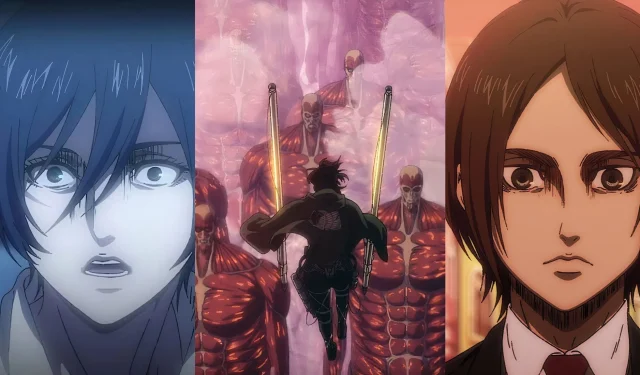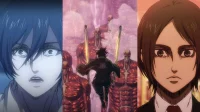Overview
- Attack on Titan’s original ending was influenced by the film “The Mist.”
- The conclusion of “The Mist”explored themes of despair associated with the continuation of the Rumbling.
- The film’s dark ending left characters grappling with regret and unforeseen consequences.
Table of Contents
- Insight into Isayama’s Initial Plans
- Understanding “The Mist”
-
Analyzing a Potential “Attack on Titan”Mist Ending
The question of how Attack on Titan could have ended differently is both thought-provoking and frequently pondered by fans. This inquiry touches on the depths of creator Hajime Isayama’s crafting process, which has been marked by significant challenges, particularly with the series conclusion that left some fans dissatisfied. At one stage, Isayama envisioned an ending akin to that of the film The Mist.
The Mist serves as a potential unofficial alternate ending to Shingeki no Kyojin, offering a glimpse into how events might unfold had Isayama followed that darker path. As we delve into the details, various possible outcomes emerge.
Insight into Isayama’s Initial Plans
Watch the Interview
In a pivotal 2013 discussion featured on Comic Natalie, Isayama disclosed a shift in his vision for the ending of Attack on Titan. He reflected:
“Although I’m progressing towards the ending that had been set before, my approach towards the ending itself has changed. Because now I feel responsible towards the reader. I originally wanted to illustrate something similar to the film The Mist.”
This is not the first instance of Isayama expressing disappointment with certain aspects of the series finale. He even issued an apology to fans during an Anime NYC event in 2022.
Moreover, the evolution of the plot in response to external pressures is a recurrent theme, including the controversial decision to spare Levi, a fan-favorite, after his editor, Shintaro Kawakubo, persuaded Isayama against ending his character’s journey prematurely.
Understanding “The Mist”
Watch the Trailer
Released in 2007, The Mist arrived shortly after the publication of Attack on Titan’s original one-shot, representing a significant narrative influence. The film stands out for its considerably darker ending compared to the source material.
Set in a small Maine town, the plot centers around townspeople trapped in a supermarket as a terrifying mist filled with monstrous entities envelops them. This setting breeds tension, highlighting the psychological unraveling among the confined survivors.
The culmination of the film is particularly haunting: in a moment of desperation, the protagonist, David, resorts to murdering his companions, believing it to be an act of mercy, only to discover moments later that salvation was just within reach. This shocking twist instills a profound sense of regret.
Analyzing a Potential “Attack on Titan”Mist Ending
Isayama elaborated upon his concept for a Mist-inspired ending during the previously mentioned interview, which has since become a topic of dialogue within the fan community. In another fan translation, he stated:
“By the middle of the film, the story of The Mist is at the typical level of a B-list movie. But at its conclusion, it used the main character’s deep, intrinsic beliefs of what’s right to corrupt the main character himself, leading him to act in contrary ways.”
This suggests Isayama was contemplating an ending that would significantly challenge audience expectations through the protagonist’s moral dichotomy.
The Role of the Rumbling in the Hypothetical Ending
Potential Insights
The meticulous planning behind Attack on Titan’s narrative has been crucial to its acclaim, allowing for intricate plot twists and suspenseful setups. A notable example includes the ‘2,000 Years’ reference from the series’ onset.
Eren’s relentless drive to eliminate the Titans firmly establishes the character’s motivations. His inclination toward violence not only complicates his childhood but also creates challenges for those like Mikasa who endeavor to protect him.
If Isayama’s original ending mirrored the themes of The Mist, it could culminate in Eren’s realization that the survival of Titans might be essential for achieving his goals, thereby linking concepts from both narratives. Given the events leading up to the Rumbling, it is plausible that this mechanism served as a pivotal element of the alternative ending.
Furthermore, Isayama hinted at a narrative twist that would subvert audience assumptions, akin to the revelations in The Mist. This invites speculation regarding the Rumbling’s implications in the final act of Attack on Titan.
Scenario 1: The World Faces Extinction
One possible interpretation of an Attack on Titan ending inspired by The Mist could depict a world irreparably altered by the unstoppable Rumbling.
Imagine a scenario where Mikasa defeats Eren’s Founding Titan, yet the Wall Titans continue their devastation, ultimately leading to apocalyptic outcomes. In this alternate conclusion, Mikasa may confront her fading hope, grappling with the futility of her actions and the enormity of loss.
This scenario may follow a darker narrative path than portrayed in the original series while still echoing thematic sentiments from The Mist.
Scenario 2: Eren’s Pyrrhic Victory
Alternatively, another potential ending could see Eren fulfill his destructive ambitions yet face a hollow triumph.
If Eren’s Founding Titan prevails against the Survey Corps and the Rumbling devastates the world, he could stand alone as the sole survivor, recognized as a hero among the people of Paradis Island. However, this victory would be marred by the weight of his actions, knowing his loved ones have perished.
In this reality, remnants of resistance could emerge years later, hinting at an unending cycle of conflict reminiscent of the series’ epilogue. Mikasa, Armin, and the others’ sacrifices would echo the tragic themes of loss present in The Mist.
As of now, no confirmed details from Isayama have surfaced regarding deviations from the actual ending of Attack on Titan. Fans continue to speculate about alternative possibilities, ensuring discussions around the series’ conclusion will persist far into the future.


